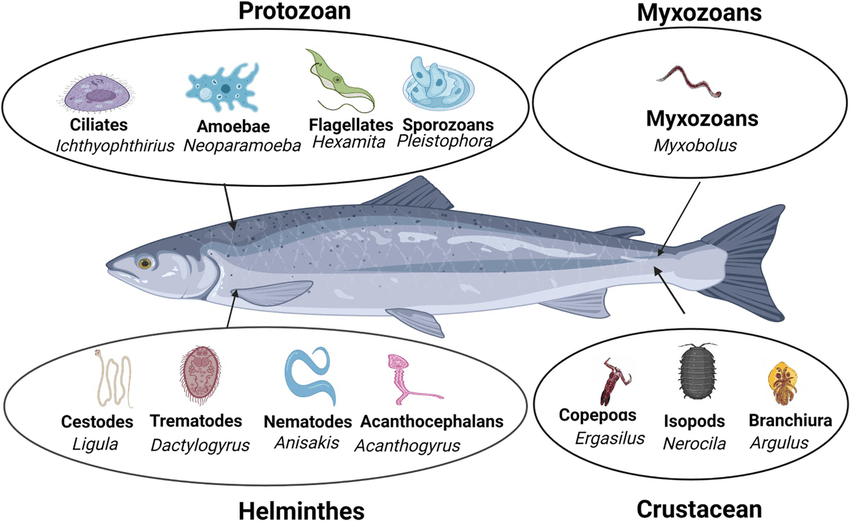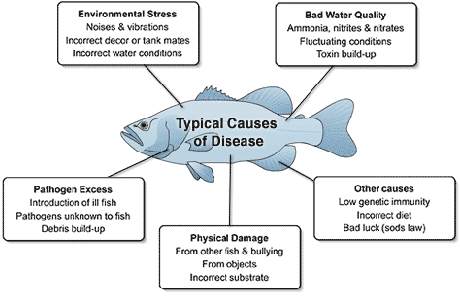Parasitic diseases of fishes which can also be referred to as fish parasites and diseases are usually encountered more often than microbial diseases. From 30 to 50 percent of the cases received at several fish disease diagnostic laboratories involve parasites.
Host reaction to parasitic invasion is highly variable. Fish parasites and diseases are significant challenges in fish farming, impacting fish health and farm productivity.
The severity of a parasite epizootic may be related to environmental factors; host condition, age, and size; and population density. Bacteria pathogens associated with fish into two: the non- indigenous bacteria pathogen and the indigenous bacteria pathogens.
The non-indigenous pathogen contaminate fish or fish’s habitat in one way or the other and the pathogens include Clostridium botulinum, Listeria monocytogenes, Staphylococcus aureus, Salmonella species, Shigalla species, Escherichia coli, etc. The indigenous bacteria pathogens are those naturally living in the fish’s habitat.
1. Fish Parasites

Parasites can be internal or external, ranging from microscopic protozoa to larger organisms like worms and crustaceans. Common parasites include:
Protozoa: Such as Ichthyophthirius multifiliis (Ich), causing white spots on fish.
Monogeneans: Flatworms affecting gills and skin, leading to irritation and breathing difficulties.
Cestodes and Nematodes: Tapeworms and roundworms that infect the intestines, affecting nutrient absorption and growth.
Copepods: Like Lernaea (anchor worms), attaching to the skin and causing lesions.
2. Fish Diseases

Diseases in fish can be caused by bacteria, viruses, or fungi:
Bacterial Diseases: Common ones include Aeromonas and Vibrio infections, causing ulcers, hemorrhaging, and systemic infections.
Viral Diseases: Examples are Infectious Hematopoietic Necrosis Virus (IHNV) and Koi Herpesvirus (KHV), which can cause high mortality rates.
Fungal Diseases: Fungi like Saprolegnia can infect damaged skin or eggs, leading to cotton-like growths and decay.
Read Also: The External Anatomy of a Bony Fish
Procedures for Identification of Fish Parasites and Diseases

a. Microscopic inspection of smeared slides e.g. slime or wound
Microscopic Examination Bacteriological examination is completed by a microscopic search for bacteria, in spoiled cans directly upon sampling or after incubation. Usually a wet preparation of smeared contents examined under phase contrast microscope is sufficient to detect microorganisms.
b. Identification of associated pathogenic organism e.g. bacteria, fungus, protozoa
Collect the infected parts of the fish aseptically by using sterile forceps and scissors. Homogenized collected sample in sterile mortar and pestle using phosphate buffer as solvent.
Serially diluted homogenized samples up to 10-6. Pour one millilitre of diluted sample from each dilution into sterile petri dishes followed by sterilized molten agar medium
After solidification, were inverted all the plates and incubated in a thermostat incubator to allow the growth of bacteria. After incubation, the colonies appeared on the respective agar plates. Finally, the cultures were stored in respective agar slants for further use and identification using microscope.
Read Also: Introduction to Fisheries Ecology
Methods for application of anti-bacteria’s to fish according to Haya et al., 2005.
| Method of application | ||||
| Oral route on food | Needs palatable components; environmental pollution | |||
| Bioencapsulation | Needs palatable compounds; environmental pollution | |||
| Bath | Need for a fairly lengthy exposure to the compound, which must be soluble or capable of being adequately dispersed; problem of the disposal of spent drug | |||
| Dip | Brief immersion in a compound, which must be soluble or capable of being adequately dispersed; problem of disposal of the dilute compound | |||
| Flush | Compound added to a fish holding facility for brief exposure to fish; must be soluble or capable of being adequately dispersed; poses a problem of environmental pollution | |||
| Injection | Feasible for only large and/or valuable fish; usually requires prior anaesthesia; slow; negligible risk of environmental pollution | |||
| Topical application | Feasible for the treatment of ulcers on valuable/pet fish |
In summary, diseases and parasitic problems could constitute significant economic losses in fish production if not controlled, thus the need to continue monitoring its prevalence. Ability to identify associated pathogenic organism in the ecosystem and apply antibacterial of methods is critical to sustainable fisheries management.
Preventing and managing these issues involves maintaining high water quality, providing balanced nutrition, and reducing stress through proper handling. Quarantining new fish, regular health monitoring, and prompt treatment with appropriate medications or interventions are crucial for minimizing the impact of parasites and diseases on your fish farm.
